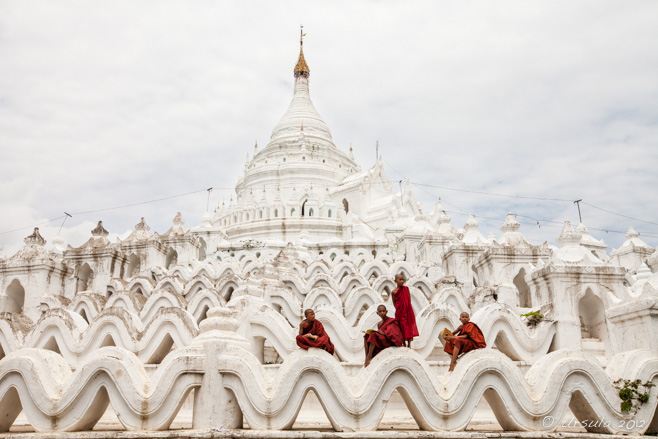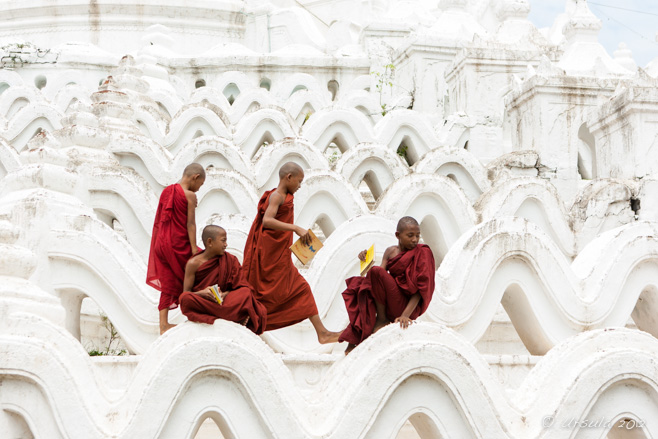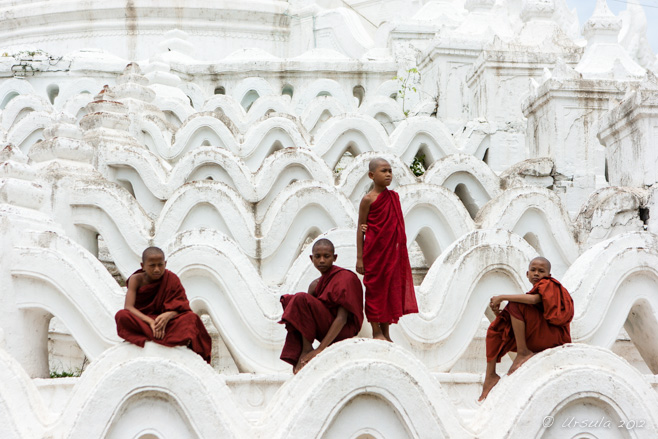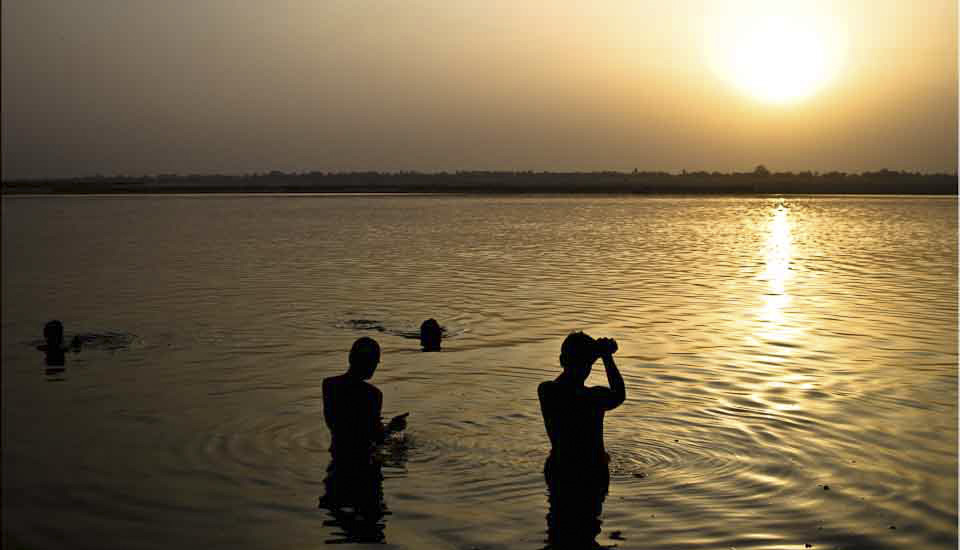 Hsinbyume Pagoda
Seven concentric terraces, representing the seven mountain ranges going up to the mythological Mount Meru, form the base of Hsinbyume Pagoda, Mingun. There are ups and downs when traveling with a photo group.
One of the most important advantages is time: a group of people aiming to make pictures will often stay in one place long enough to experiment with light and angles and to focus on details, long enough to make the average non-photographer fidget with boredom and restlessness.
Being with a group of photo enthusiasts means that you have access to lots of advice and input. On the flip side, it can also mean being overwhelmed by other people’s styles and and ideas, and having difficulty holding on to your own.
It means being put in the right place a the right time. It also means competing for space and having to work around others – and taking lots of dud pictures that include other people’s lenses, feet, heads, flashes, and other body- and camera-bits.
Sometimes, like at Hsinbyume Pagoda in Myanmar last September, with photographer Karl Grobl and guide Mr MM, it means having “models” organised. This is always a lot of fun, and is much easier than negotiating permission with subjects yourself. However, it also means waiting your turn while subjects wilt in the heat, losing the moment, or having the eyes of your subject drawn away by someone else, just as you are about to take the picture you have been warming them up to.
But, it provides a welcome opportunity for photographic exercise. For me, Hsinbyume Pagoda was a challenge in lighting: dark skinned novices in dark robes contrasting severely with a white pagoda against a whiter-than-white sky; dark skinned novices in dark robes disappearing in the dimness of the pagoda’s interiors.
It also gave me a chance to make the kind of “orchestrated” photos that I don’t normally take.
 Novices on the Waves
Four young novices arrange themselves on the terraces at the base of Hsinbyume Pagoda.  Ready!
The young novices wait for everyone to take their pictures.  Little Novice
Against the white waves of the pagoda, glaring in the heat, a young novice tidies his robes.  Little Novice  Don’t tell the Abbot!  Novice on the Run
Our novices engage in some rather un-monkly behaviour for our benefit.  Novice on the Waves  Novice in Flight  The whole group climbs the stairs up to the pagoda…  … to take pictures of a young novice on the path outside it.  In the Heat of the Day  Novice in a Doorway
Inside the pagoda, it is dark and textured –  Novice in a Doorway
– making a foil for the young novices.  Novice on a Walkway
Outside, on the walkway, the heat continues to radiate in all directions.  Prayers
Meanwhile, inside, a couple say their prayers…  … and the grass grows wild and rubbish collects on the terraces.  Soon it is time to descend the stairs, pass the money collection bins, and exit the pagoda ~ and to reenter the “every day” world… where more “natural” photos await. Certainly, there are pros and cons of traveling with a photo group.
 But I love that it gets me to places I might not otherwise go, and stretches me to make pictures I might not otherwise attempt. But I love that it gets me to places I might not otherwise go, and stretches me to make pictures I might not otherwise attempt.
And, ultimately, it means coming home with so many pictures it is hard to know where to start!
‘Till next week…
Pictures: 15September2012
Posted in Myanmar,Portraits,TravelTags: architecture,blog,buddhism,buddhist,children,environmental portrait,Myanmar,people,Photo Blog,portrait,portraits,religion,temple,travel,Travel Blog,Ursula Wall,worship
 Kings Road, Brighton
Rugged-up against the weather, pedestrians make the best of a break in the rain. Rumour has it that Great Britain has experienced a true summer this last July. This “heatwave” has health professionals worried, while other Britons head to the beach to bask.
Of course, it isn’t usually so. Last July, when we visited Brighton Beach for two days, the weather – rain and black clouds with intermittent sunshine – was probably more typical of an “average” British summer.
Naturally, if you only have a day or so to visit a place, you take the weather as it comes! But, while Brighton has been known as a health resort for sea bathing since the 18th century, and became a popular day-trip destination for Londoners with the arrival of the railway in 1841, it really wasn’t turning the beach weather on for us.
 West Pier
Built in 1866 and abandoned in 1975, the ruins of the West Pier sit against threatening black clouds. Hardy Britons enjoy the waterfront regardless.  Hot Fish
No matter what the weather – it is always time for fresh fish and chips!  Beach Ball and Chain?
Brighton’s waterfront is reflected in a large disco ball.  On the Pier
Protected from the elements by raincoats and umbrellas, tourists venture out onto the famous pier.  Look to the Surf…
Bodyboarders defy the cold Atlantic to catch a few “waves”.  Tarot and Rain
“I see showers in your future.”  Rain and Lace
Built between 1891 and 1899, the Brighton Marine Palace and Pier, as it is officially called, features some wonderful wrought iron work.  The Brighton Wheel
Not too many takers on this day; the carriages all appear to be empty.  Dress Shop
Taking refuge in quaint stores is one way to escape the climate.  The Royal Pavilion
Built in the Indo-Saracenic style popular in colonial India in the 19th century, the Brighton Pavilion was a royal retreat for George, Prince of Wales, later King George IV, from 1787 onwards.  Playing the Crowd
During a brief respite from the rain, people wander through the Royal Pavilion grounds.  Clarinet and Bubbles
Like magical musical notes, bubbles float on the air while the clarinetist plays on.  Brighton Street
The next day, the weather was much improved…  Brighton Beach
… but black clouds still loomed over the rocky, shingle beach.  Beach Chairs
Canvas chairs sit empty.  Rust and Ruin
Old boats and bits of machinery are out-door parts of the Brighton Fishing Museum.  Cockles and Lobster Tail
Cups of fresh seafood are available from the fridge…  Smokehouse Door
… or you can buy something from one of the many shops in the converted row of Victorian fishermen’s workshops.  Punch
Originally the Italian Pulcinella, Punch (with Judy and a cast of characters) became synonymous with beach entertainment.  Fish Nets and Crab Traps
The Brighton Fishing Museum is dedicated to all things maritime.  Carousel  Pigs!
Shop keepers, trusting the rain would hold off, moved their wares out of doors.  Royal Pavilion
After walking the distance between the two piers, we couldn’t resist returning to see what the Royal Pavilion looked like in better weather …  Domes and Minarets
… and it is lovely …  Brighton Royal Palace Gardens
… but, as dark clouds rolled in again, we decided it was best to leave!  We escaped back to our vehicle – umbrellas hoisted – as the raindrops started to fall.. We escaped back to our vehicle – umbrellas hoisted – as the raindrops started to fall..
I hope this year’s visitors realise how lucky they are to have genuine summer, beach weather.
Happy Travels!
Pictures: 14-15July2012
Posted in Great Britain,Landscapes,TravelTags: architecture,beach,blog,boats,England,Great Britain,Photo Blog,travel,Travel Blog,United Kingdom,Ursula Wall
 Morning is Breaking
The sun peaks over the Bodie Hills and through the Red Cloud Mine head-frame and man lifts.
Bodie State Historic Park, California, USA Cold.
Dark. Completely dark – but for the stars overhead – and cold.
And early! Way too early.
It was 5:15am in California’s Eastern Sierras. A small clutch of cars and a congregated group of people with their hands shoved deep in their pockets, huddled against the kind of piercing cold that only a dry climate can produce in high summer, were stopped at the entry to Bodie State Historic Park,
It was 14 miles (three of them unpaved: rough and bumpy) from the nearest tiny town, and we were waiting for a Park Ranger to arrive and grant us access to the grounds. On the third Saturday of every summer month, the Bodie Foundation gives people the opportunity to photograph the Californian gold mining ghost town of Bodie in the early morning light (for a fee).
 Head Frame and Machinery
The first sights, once we are out of the car park, are old bits of mine machinery: rough and textured in the pre-dawn light. This early access allows photographers to wander around the almost-empty town before the “tourists” arrive at the official opening time of 9:00am. For me, it was a chance to try out the new tripod I had bought especially for the occasion. Tripods are a handicap rather than an asset on the kind of travelling I usually do, so this was a rare opportunity to practice shooting with one.
 Pre-Dawn over Bodie
What is left of what was once a thriving (and nefarious) mining town is preserved in a state of “arrested decay.”  Bodie Ruins
The ramshackle nature of Bodie reminded me of Sweethaven, the town that threatens to fall into the sea in the 1980 film “Popeye“.  Methodist Church
Built in 1882, the Methodist Church is the only church remaining in town. The last service was held here in 1932 when the town was already in serious decline. Named for Waterman (William) S. Body who found gold in the hills here in 1859, Bodie grew to be a town of 10,000 by 1879. The two churches were no match for the 65 saloons and rugged lifestyle; Bodie soon became known as the “most lawless, wildest and toughest mining camp the far west has ever known”. Robberies, stage hold-ups, street-fights and even murders were almost-daily events.
Bodie’s heyday was short-lived: by 1881, mining declined and homes and businesses were abandoned. Fires in 1892 and 1932 destroyed much of the town. Although it has been referred to as a “ghost town” since 1915, Bodie still had a total of 120 people at the 1920 US Federal Census, and has never been completely abandoned: dropping to three residents in 1943. Today, some of the California State Park rangers live on site, and we had to shoot “around” a modern white vehicle that was parked in plain view.
 Sunrise over Bodie
Some of the 110 remaining buildings in the morning sunlight.  Bodie Sawmill
Remnants of old buildings give us some insight into the workings of the town.  JS Cain House
Looking through the windows to see what old wares have been left in the dilapidated buildings is part of the Bodie adventure.  Bird on a Wire
Swallows are some of the many birds who make Bodie their home.  Sunbeams and Sage
As the sun warms up the landscape, the wonderful smell of sage grows stronger.  Buildings and Machinery  Bodie Wagon  Through the Windows
Smeary shopfront windows hide a treasure-trove of old wares.  Gas Pumps and Dodge Graham  A Music Room  Young Blackbird  Ranger Aleta
A ranger talks about Bodie’s history, while cleaning the schoolhouse windows.  Education: A Window on the World
Light and reflections through the schoolhouse windows.  Cottage Fence  Bodie Hills  Rusty Pipes
Bodie is a genuine ghost town: bits of rust, glass and broken wood are everywhere!  Bodie Truck  Diagonals  Through the Frames  Through and Back  Lines of Light  Hotel Reflections
Patterned reflections in the front of the Wheaton & Hollis Hotel.  Leading Lines
Some old pipes in the grass lead the way back to the car park.  By eleven o’clock, the sun was high overhead, and the air was radiating heat. By eleven o’clock, the sun was high overhead, and the air was radiating heat.
It was time to leave the site to the tourists, armed with their guidebooks.
And the ghosts.
Happy Rambling!
Photographs: 20July2013
Posted in America,Architecture,History,USATags: architecture,blog,history,museum,Photo Blog,ruins,State Park,travel,Travel Blog,Ursula Wall,USA
 Dandelion Cliffs
Sunny dandelions greeted us as we climbed the walkway to view the magnificent Cliffs of Moher, County Clare, Ireland. It was pouring.
Of course it was! It rained every day of our visit to Ireland last June. Not all day, but every day.
The silver lining was that were were going to be comfortably seated on a bus tour of County Clare all day, and not walking the wilds of the Dingle Peninsula, County Kerry, as we had been the day before. And, it IS that rain, after all, that makes Ireland the “Emerald Isle”.
We were meant to be heading into some of Ireland’s “most stunning scenery”. So, we picked up our umbrellas, packed our raincoats, and crossed our fingers.
It was still pouring when we arrived at our first brief stop at the ruins of Leamaneh Castle; my husband (holding the umbrella) and I (wielding the camera) were the only members of the tour group who even got out of the bus.
 Leamenagh Castle Ruins
The original Leamenagh Castle was built around 1480 by one of the last High Kings of Ireland. The manor house was added in 1648 by Conor O’Brien and his wife, Máire ní Mahon. Connor died early, and his widow became known as “Máire Rúa” (Red Mary) due to her flaming red hair. She is one of the most infamous women in Irish folklore, probably because she was able to retain her estate via two politically astute marriages. The rain continued as we pulled up to our second, longer, stop at Caherconnell Stone Fort, a stone ringfort dating back to 400 AD. We braved the wet and took the self-guided tour through the magnificent stone ruins.
 Caherconnell Stone Fort
The self-guided tour takes the visitor through the ringfort, built by farmers around 400 AD and left much as it has been found.  Walls of the Fort
Like other ringforts, Caherconnell was probably built as a defence against animals and raiders. Almost perfectly round, and between 140-145 feet in external diameter, it would have housed a small settlement.  Hawthorn
Ringforts are commonly referred to as fairy forts: fairies live in the forts or in the hawthorn trees that grow in them. It is considered unlucky to cut these trees down.  Ferns
The walls are 12 feet thick, built from large blocks, as much as three feet long and two and a half feet high. This makes them a perfect home for moss and ferns. The rains eased off but the grey skies hovered for our third stop at a portal tomb: the fascinating Poulnabrone Dolmen – a neolithic burial site probably dating between 4200 BCE and 2900 BCE.
 Poulnabrone Tomb
Poulnabrone dolmen (Poll na mBrón in Irish, meaning “hole of the quern stones”) is a neolithic portal tomb thought to date to 3800 BCE.  Poulnabrone Tomb
The twelve-foot slab-like capstone sits on slender portal stones. The chamber underneath was the last resting place for almost thirty adults and children, as well as various personal items.  Limestone Pavement
The porous limestone pavement around the tomb is pockmarked and slippery with moss and moisture. I was thrilled to stop for lunch overlooking Galway Bay, not only because I was hungry and and the food was terrific, but because I could muse about my ancestors who had emigrated from across those same waters only a few generations before.
 Galway Bay
Calm waters and a patch of blue sky greet us at our lunch stop in Ballyvaughan Village.  Monks Pub
Justifiably famous for its seafood, the pub was a welcome stop. As the skies cleared further and the sun came out, we continued southwest across the Burren (Boíreann, Irish for “rocky place”) and stopped for a scramble across the glaciated limestone karst “pavement”.
 The Burren
Ponies graze on the short grasses that grow in the sparse soils atop the limestone rocks.  Stone Wall  Still Life Found: Stones and Flowers
Livestock love the Burren because the limestone holds the heat.  Flowers in the Fissures
The vertical fissures (grikes) hold water, supporting pockets of plant life.  Puddles of Life  Bus on the Burren
Our bus sits on the Black Head Coastal Drive, awaiting our return, so we can drive to our last stop.  Cliffs of Moher
Our final stop is at the stunning 214m (702 feet) tall Cliffs of Moher – thank heavens the sun is shining!  Curving Cliffs
The cliffs, which have been used in numerous movies, including The Princess Bride (1987), stretch for 8 kilometres (5 miles) along the Atlantic coast.  Information Centre
The Visitor’s Centre, featuring informative displays and stunning photographs, includes cafeterias, restrooms, and a gift shop. It is built into the hillside, but surprisingly light and airy inside.  O’Brien’s Tower
In the other direction lies O’Brien’s Tower, built in 1835 by Cornelius O’ Brien, and used as an observation tower.  Cliff Tunnel
Comprised of bands of Namurian sandstone, siltstone, and shale, the cliffs are wonderfully varied, and noisy with nesting bird life.  Dandelion Cliffs
One last look at the towering cliffs, and it is time to return to our lodgings in Shannon.  The Great Hunger
On the way home, we stop briefly at the statue of an orphan child at a Poorhouse door – a grim reminder of another facet of Ireland’s long and rich history.  It was a typical Irish day: starting in rain and ending in brilliant weather. It was a typical Irish day: starting in rain and ending in brilliant weather.
We heard historical tales – ancient and modern – told with a mixture of poignance and humour. We experienced remarkable sights, natural and man-made.
And, it goes without saying, we ate and drank well.
Sláinte!
Pictures: 28June2012
Posted in History,Ireland,Landscapes,Nature,TravelTags: blog,Co. Clare,history,nature,Photo Blog,ruins,scenery,travel,Travel Blog,Ursula Wall
 Market Fresh!
There is always an array of colourful fruit and vegetables at the morning street market. It’s just a simple burmese morning market – in a dirty dusty street somewhere in Mandalay. Most of the vendors are seated on the ground on woven bamboo mats. The rubbish and the dogs threaten to encroach on the wares for sale.
But, the vegetables are fresh, and the smiles are freely given.
I love exploring the markets in Asia. As tricky as they can be to navigate and photograph, they are a feast for the senses and the camera.
I just couldn’t tell you exactly where this one was!
Karl Grobl, our photographic mentor, and Mr MM, our burmese guide, had dropped us (ten enthusiasts with cameras) off the bus somewhere in the Mandalay area and sent us off to explore…
 Waiting for a Sale
A vendor sits on the ground, surrounded by her beans.  Sprouting
Many of the beans and legumes are sprouting.  The Sale is Made.  At the Butcher’s
The selection is small…  Butcher’s Block
… but attention is immediate.  Fresh-Water Fish
Caught daily in the rivers nearby.  Sales Lady
A typical burmese woman: sporting thanakha, lucky flowers and a big smile.  Fresh Flowers  Young Lad
Managing a morning market is a family affair.  Let the Procession Begin!
There is some sort of Buddhist celebration going on…  Bell Gong
The noise from the flat gong is amazing loud – but the locals are used to it!  Bell Carrier  Rubbish in the River
A waterway, almost choked with floating rubbish, separates the market from the rest of town.  Monk on the Bridge  Man on the Bridge  Groceries on the Bridge  Barrels
I have no idea what these barrels contain, but I loved the colours.  Market Scene
Typical street market street scene, complete with motorcycle, local dog, and elegant women walking tall with baskets on their heads.  Friends
Smiles are everywhere.  Bicycle
Draped in tarps, a precious bicycle sits parked in the rubbish behind the main market “stalls”.  Boys with ‘Tude
Some young men on the back of a delivery truck watch me…  Wreathed Like a Caesar
… and are quick to flash that famous smile.  Burmese Kyat
Returning to the start of the market, I find the first vegetable seller with her hands full of money…  Veggie Seller
… she’s happy and relaxed now that she has made several sales.  It was impossible to get lost – this market wasn’t very big. It was impossible to get lost – this market wasn’t very big.
It was also impossible to leave without smiling – in spite of their simple surounds, the people in the markets were friendly and welcoming.
A lesson for us all?
Keep Smiling!
Pictures: 15Septemeber2012
Posted in Culture,Every Day Life,Myanmar,PortraitsTags: blog,environmental portrait,environmental portraits,fruit and vegetable,market,markets,people,Photo Blog,portrait,portraits,travel,Travel Blog,Ursula Wall
« Older posts
Newer posts »
|


















 But I love that it gets me to places I might not otherwise go, and stretches me to make pictures I might not otherwise attempt.
But I love that it gets me to places I might not otherwise go, and stretches me to make pictures I might not otherwise attempt.




















 We escaped back to our vehicle – umbrellas hoisted – as the raindrops started to fall..
We escaped back to our vehicle – umbrellas hoisted – as the raindrops started to fall..

























 By eleven o’clock, the sun was high overhead, and the air was radiating heat.
By eleven o’clock, the sun was high overhead, and the air was radiating heat.













































































Orchestrated your photos – but nevertheless wonderful!
Anna :o]
Thanks, Anna :o]! Lovely to have your company. 🙂
I love this series. Beautiful captures. Greetings and nice week Dietmut
Thanks, Dietmut. The novices were fun!
Hi Ursula,
i’m Claudio from Italy,
could i use your stunning Little Novice photo in a catalogue, for a new organic, biological and ethically produced cosmetic skincare? Let me know if it’s possible.
Thank you in advance for your disposability and compliments for your works.
Thanks, Claudio! I have emailed you. 😀